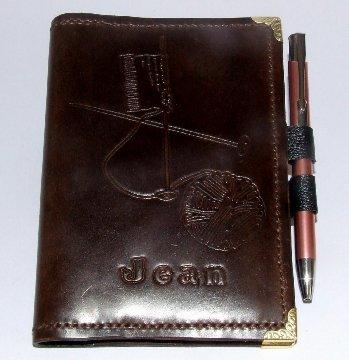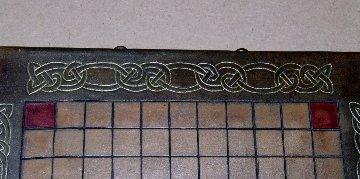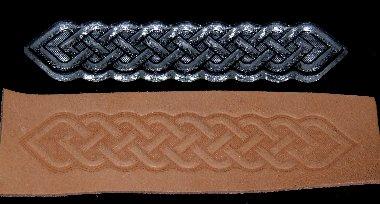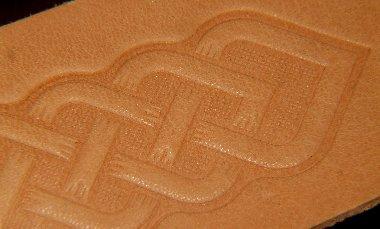-
Posts
5,904 -
Joined
Content Type
Profiles
Forums
Events
Blogs
Gallery
Everything posted by fredk
-
Would HDPE or Delrin work for you? Thats what I use under my shape cutters (I'll not raise them to the level of clicker dies, ) I'm only cutting out, (stamping out), small shapes from up to 1mm suede or pigskin for bases to put on games playing pieces I get my sheets from this place: https://www.ebay.co.uk/str/gfgplasticsltd I've never really damaged a sheet yet. I buy a lot of nylon, delrin or HDPE sheets from them as I use the sheets for all sorts of odd jobs, like sticking wet & dry paper to for a flat sanding surface
-
All stamping should take time. When you use a bar and hammer, walk the the stamp. 1st hit, centre to locate it, then tip to top left, hit again, tip to top right, hit, tip to bottom right, hit. tip to bottom left, hit. Finish with another centred hit. All this takes more than 20 seconds. The time is needed for the leather fibres to become fully compressed and retain that compression. If you just press down briefly and release the fibres can reshape themselves a bit after release of the pressure on them Try it this way and you'll find you get sharper more permanent impressions
-
The grey one; https://tandyleather.world/products/craftool-pro-hand-press?_pos=3&_sid=2f2862f43&_ss=r I preferred the grey one as I bought the adaptors for the 3D/2D stamps for it https://tandyleather.world/products/press-dies-for-hand-press?pr_prod_strat=copurchase&pr_rec_pid=4602824392839&pr_ref_pid=4602666549383&pr_seq=uniform Not many people do this; ~~ its not just about pressing the stamp, the leather needs to be cased just about right, and leave the pressure on for about 20 seconds or more Would you believe that no place in my country had an arbor press of any size. Only one was willing to import one. It was large and was 12T pressure and was going to cost around £600. Tandy had theirs on sale so I got it for about £180 Nonsense. The Tandy is 1.25 T and if I don't carefully adjust its depth to press I can, and have, punched a stamp right through 3mm thick l leather. Just the other night I tested a self-made resin stamp on 2mm leather. I didn't use the press nor a hammer, I just pressed it down hard on the cased leather and held it there for about 20 seconds. I got a very decent test stamping, not great but passable
-
With the Tandy press I can screw the end of the ram up or down so I bring the ram down to the leather and adjust it so that the stamp is just pressed into the leather by a few millimetres. I also use various thickness of delrin sheet as a base
-
I have and use the Tandy press. 1.25T pressure afair. More expensive than a bog-standard arbor press
-

Doubts about leather for boots
fredk replied to Kovant's topic in Shoes, Boots, Sandals and Moccassins
Short answer, yes you can. even shorter answer, yes I never made shoes or boots from new, just repaired plenty and I used the same leather I used for making bags et cetera I found that belly leather, about 1.5 to 2mm, was good for wet forming over the last for the vamp -
I was in Hobbycraft today and tried to check out one of their card cutting presses. I say tried, cos they were out of stock. However, a nice young lady went and searched out the information required. This is for their machine priced at £54. https://www.hobbycraft.co.uk/sizzix-big-shot-die-cutting-machine/606169-1000 Cutting width is 15.6 cm Cutting depth is 1.6 centimeters, so I was waaaay off I reckon this has potential. I'm for ordering one of these machines I already use some of the card cutting steel templates for impressing into leather. Here is just one example, the knitting things, not the letters*. You can buy literally thousands of different pictures in different sizes for only a £/$ or two through ebay * I got the angle wrong on this one, the knitting looks too much like a flag, but the lady still liked it and a correction from me, I kept calling this a 4 piece set, its only 3 piece and its his number 4 set. I got the numbers mixed up
-
Thats pretty good so it is I really like the rough look to the bevelling (?) around everything. I think that just makes it extra so different
-
I've used woodworkers type PVA glue which is water based. I usually use a solvent contact adhesive. One thing that I've found is that the water based glue will shrink the leather, as any water used on leather will do. I've used the PVA on re-wrapping sword grips and the nature that the leather will shrink as the glue dries out pulls the leather tight, and this needs to be taken into consideration in making sure there is sufficient leather. A solvent adhesive does not, in my experience, shrink the leather at all.
-
Measure the length you need and note the cross-section profile, then try at an auto parts store We have the same problem with our 1930 to 1934 Austin cars and thats how we get fan and drive belts for them
-
you guys need a time to have a beer ?!? I just have one when I fancy one. Its simpler that way
-
Nicely made
-
1. I use them in my Tandy press which is about 1.25 tons pressure afair 2. I use a 3mm steel plate over them to spread the load. The plate is the width of the stamp and the length of the longest piece 3. I adjust my press so that the stamp (any stamp) goes only so far into the leather 4. On the first stamp I do the centre of the stamp first to locate it then I work to the left of centre, then the right of centre. I know when its stamped well as a further pull on the press handle does not put any more pressure on the stamp 5. (See below) on the next stamps I first do the end which goes on the end of the last piece, then the centre, left and right et cetera 6. On other stamping/embossing tools I have you need to align the ends of the first stamping with the next one and so on. It needs very careful alignment to get it straight and no gaps. With the stamps this Russian chappie makes you overlap the second piece onto the end of the first. This does two things. 1. you get perfect alignment, 2. you can adjust the overlap to make the total stamping different lengths. This overlap is why in 5 above I do the end of the next piece first, to fix it in place. 7. They are excellent quality. They are thick enough for use and very detailed. As the chappie says, they are for use in a press, not for use with a hammer 8. Plenty of detail. How much do you need? I use these as a border on some game boards. It used to take me several hours to do four of these Celtic lace designs on a board Now I can do all four in about 15 minutes, and that suits super-lazy me! This is the short one piece one. I bought this one first, found it was too short for my liking so I then bought the 4 piece set. This is just a test/sample pressing which I keep with the stamp. Its on too thin a leather for the stamps best to show up A close-up of part of the stamping Plenty of detail there to keep me happy
-
Is this the one you know of? Its the chappie I've bought from. A good & helpful chap. Currently, toolmaniac https://www.ebay.co.uk/sch/toolmaniac/m.html?ssPageName=STRK%3AMEFSXS%3AMESOI&_trksid=p2053788.m1543.l2654 I've bought two items from him. 1. a single short Celtic lace: https://www.ebay.co.uk/itm/Celtic-Style-Leather-Belts-Embossing-Stamp-For-embossing-VegTan-Tooling-Leather/224174510639?hash=item3431d7922f:g:KMoAAOSww5hZNZki 2. a 4 piece Celtic lace: https://www.ebay.co.uk/itm/Stamp-Set-4-for-Embossing-Vegetable-Tannned-Tooling-Leather-Belt-Blanks/224174509535?hash=item3431d78ddf:g:KPAAAOSwEHpZNZkh edited, to add. A few years ago a friend jokingly suggested I get a table top old fashioned clothes wringer for embossing larger areas, eg book cover fronts. I've considered them but they go for top ££
-
The roller machines for die cutting card for card making have a small limit on what can go through them, max is about 4mm (thin aluminium sheet, card stock of max 200gsm, metal die of 2 mm and another aluminium sheet). I have a set of the acrylic embossing stamps by that Russian chappie. The stamps are about 4mm. Then add your belt leather, minimum of 3mm. I'll have another look at these machines when I'm at Hobbycraft next
-
Have you got any beeswax & nfo mix? rub some of that in. Let it rest in a warm place for a while then work the leather. You might have to repeat this, but that should do the necessary
-
Extreme measure; get some lacquer thinners (aka cellulose thinners). Soak a clean rag with it and apply to the spot. Get that spot really wet with the thinners and rub vigorously with the clean rag, turn the rag to a clean section as you go. The thinners should dilute and lift a lot of the dye out. You'll need to feed the leather with nfo later as the thinners will remove the oils and dry out the leather
-
To me that is not acceptable, unless you are getting it at 50c a sq ft. I've bought 'distressed' leather from Le Prevo and its quality has been not far off 1st quality with only the occasional scar or mark on it. Even their very most poor quality hides are better than that. I'd send it back for replacement or refund
-
You should have about 3mm of the stem above the leather. Actually that silver one looks just about right When I do rivet holes in multiple layers I punch the first main hole accurately, glue the layers together then use that first hole as guide for the others, first pushing the point of a scratch awl through to make sure the punched hole will still be where I want it. I rarely use a setting bar for flat head rivets. I just put one end on my anvil and whack the other end with my hammer. They end up very flat and no marks from a setting bar.
-
WIN! It'll be a real one-of-a-kind! Nothing is a total failure in this lark. We are creating art. It may not turn out the way we planned but its still all good
-

Unapoligetically color blind.
fredk replied to sonnyboone's topic in Purses, Wallets, Belts and Miscellaneous Pocket Items
yeah, I'm offended. . . . . . . . . . . . not! I was just curious -
1. brass stamp. can be hammered or pressed into cased veg tan leather 2. can be heated, via a soldering iron or pyrogravure for pressing or stamping into chrome tan leather. Mine came with a M5 tapped hole on the back and a short stud which goes into either a soldering iron or pyrogravure 3. I got mine made in China for £14. size is 3cm across x 2 cm high, other sizes pro rata roughly
-

Unapoligetically color blind.
fredk replied to sonnyboone's topic in Purses, Wallets, Belts and Miscellaneous Pocket Items
That is nice work, very colourful But why the 'color blind' in your title? I'm colour blind but I see those colours as a nice mix -

1760 - 1780 North Carolina - leather research
fredk replied to Simeon54's topic in Historical Reenactment
The Scots never had the Guilds that England had. Look also to the Ulster-Scots of that era. A great many of the Scots who went to the North American Colonies did not go direct from Scotland but from Ulster. The Scots settlers in Ulster, from approx 1605 to 1845 were known as the New Scots. They were, and still are, very Scottish in speech, habit and tradition. The point of a cobbler not knowing how to make a saddle is not true in this case. Scots, Ulster-Scots, and Ulster-Irish could, did and still do, turn their hand to whatever is required by their community. The blacksmiths would make knives, swords, shears, pikes as soon as make farm gate fittings. The farrier would make his own horse/ass/donkey shoes and fit them - they are not made by blacksmiths. Leatherworkers, even up to the 1970s, made shoes, horse tack, school bags, brief cases, and more. -
If you don't want to wire it, sew on an edge piece, folded over top to bottom, made of thin veg tan. Wet it after its sewn on, then let it dry with weights on it to keep if flat, or any shape you want. When dry seal it well. That should stiffen the brim and make it keep its shape but also be very flexible







